The latest addition to the quotes collection:

“… decide … whether or not the goal is worth the risks involved. If it is, stop worrying …”
[Amelia Earhart]
![“Our Heads Are Round so our Thoughts Can Change Direction” [Francis Picabia]](https://foodforthought.barthel.eu/wp-content/uploads/2021/10/Picabia-Francis-Round-Heads-1200x675.jpg)
The latest addition to the quotes collection:


This is a copy of the article published originally on LinkedIn.
(5. Apr. 2017) A mere three weeks ago, I was approached for a business concept for a substantial fleet of new aircraft and the intention to get them into the air this year. Coming up not with the “usual” business model to use A320/B737 and lease it to low cost airlines, but with a challenging, new (unique) business concept.
That comes along with the need to develop plans not only for the initial routes, but for an ambitious growth plan with expansion of routes and bases across Europe. Having initial interest not just from the aircraft investors group but also from the aircraft maker, I am now heading for Routes and have been asked, what I expect from the airports to bring along.
Based on my blog article My Routes Sales Pitch, I have meanwhile worked with several airports and found a very easy “challenge” to gain understanding of what the airline expects from the airport. The results of the challenge usually gains a better understanding of the airline, a sound SWOT-understanding (SWOT = internal strength and weaknesses, external opportunities and threads). The work usually ends up with a better chance to find a partner to establish the services.
If you would have an aircraft yourself to operate from your airport. How would you utilize it?
Which routes? Do you have enough demand yourself? Or does it make sense to share the aircraft with another airport? Will you have the support from the politicians, media, industry and tourism on your side, as well as on the other (destination) side? What’s the incoming vs. outgoing, what is the seasonality? Who can you get to commit on a substantial risk share for the operations? Or is it just “good will” but no commitment?
What aircraft size do you see the business case for? Usually airports today look at low cost airlines with 150-200 seats. How does the model look with a smaller aircraft (i.e. 100 seats), what ticket prices can you sell? The price levels often do not increase in line with the sector length, so shorter sectors may be good, but they compete with ground transportation (car, bus, train). And what is the average income and the GDP in your region? Are there commercial, ethnic or cultural ties between your region and the destination? Is it more incoming or outgoing or equal split?
How is the availability qualified personnel on your local labor market? Flight crews, (line-)maintenance? How about disruptions, crew and passenger hotels? How about aircraft parking or hangar maintenance?
Make me a business case. Convince me. Or other airlines you talk to.
At CheckIn.com I developed a case study about the airport “facts” on catchment areas, compared to the reality check by the CheckIn.com pan-European algorithm. It was, it is devastating. Bad enough.
Fraport Bulgaria is 230 and 250% above CheckIn.com calculations on the simple isochrones (x minutes from the airport lives y population). Their response to the facts first was rather aggressively voiced denial; “we don’t know which brochure you refer to”. And when I’ve send them photos, they accused us of incompetence; “we have sophisticated tools, our numbers are right”. We asked. We did neither get any sound explanation, nor did they even try. Nor would they provide the name of their tool or how they came to those numbers. And +200 percent is simply beyond any “drivetime variation”. My guess: Someone made a (less) educated guess about those numbers and now don’t know where they came from; but it sure has to be an unquestionable source, everything else would be heresy, right? CheckIn.com must be wrong, because Fraport Bulgaria is beyond doubt! … Would I trust them on any demand forecasting? You got to be kidding me. And I actually thought them as a possible aircraft base. Oops…? And yes, we have a lot of airlines using our data to compare and we get the very same feedback from them, why they like CheckIn.com. Oh. And CheckIn.com is open about their “Numbers Game“.
We also worked from early February to early April on the Passenger numbers of airports. We talk just 600 airports in Europe, but for more than 50% we receive different numbers from different sources. It’s not uncommon to have different numbers even from the same airport. Or the monthly numbers not summing up to what the annual number is said to be. It’s your main KPI (key performance indicator). If you don’t manage that simple value, how should I trust any other numbers you provide? (more)
We made the basic isochrones and population total together with other data available for free on CheckIn.com to overcome the airlines’ distrust in airport data and especially airport catchment data. Quite embarrassing if you think about it, ain’t it. So you better come up with a sound business case. And at least check your base data and reference your sources.
If you have a wishlist of routes to be served, I will take them as that. A wishlist. I can get them in RoutesOnline (Opportunities) and TheRouteShop (unserved routes).
Have a sound business case compiled for certain routes, I will very likely consider how they fit aircraft rotations.
Have a sound business case for an aircraft? 24/7/365? Then I am very happy to talk to you.
0 - click to show Jürgen you liked the post![“Our Heads Are Round so our Thoughts Can Change Direction” [Francis Picabia]](https://foodforthought.barthel.eu/wp-content/uploads/2021/10/Picabia-Francis-Round-Heads-1200x675.jpg)
Airport Passenger Statistics
Catchment Area Case Study
Passenger Terminal Expo
Face to the Customer
“New Airline” Business Concept
Narrow Minded Management
 The last weeks were rather challenging. Speaking at Passenger Terminal Expo on Data Silos, Silo Thinking and the need to Tear Down the Walls, Yulia and I also worked on the update of the airport passenger statistics, adding movements to the database to expand our information. And we fell right back into The Numbers Game trap.
The last weeks were rather challenging. Speaking at Passenger Terminal Expo on Data Silos, Silo Thinking and the need to Tear Down the Walls, Yulia and I also worked on the update of the airport passenger statistics, adding movements to the database to expand our information. And we fell right back into The Numbers Game trap.
The main Key Performance Indicator (KPI), the value that reflects the “importance” of the airport, is the passenger numbers. All other KPIs, like movements, on-time-performance, revenue are scondary. Where I can understand that airports publish preliminary numbers for the press, those numbers are then updated and finalized. By that time, they reach Eurostat, national statistics, Wikipedia, ANNA.aero, Airports Council International (ACI), IATA and other official bodies. How do you define “Total Passengers”?
But then we go back to the airport’s monthly and annual passenger numbers. And to give examples that really bugged me the past weeks.

Spanish AENA had what I understood an error in their May-data. The numbers are three to four times above the average. And their own annual numbers confirm it, being about that difference too high. If I’d be lazy, I would simply correct the May numbers so the annual total matches the total given by AENA. But is that the error? Working professionally, I informed AENA (airline marketing). Matter of fact, as the airline, I’d be embarrassed and would make sure those numbers to be updated immediately. After one month of no reply, I inquired. Both verbal (phone) and e-Mail. The response was a “blame game”, I shall contact the statistics group at AENA. Excuse me? That’s your understanding of customer support? Are they unable to clear that internally, bothering the customer with the internal (bureaucratic) hierarchy? The following week, the numbers were still not updated. Now, that is embarrassing. So the fact is, I do “unprofessionally” and assume the mistake, as the data owner neglects the issue. Again. Main KPI.
And their tables? Monthly data split to 12 tables, available as Excel without the airport code. Why again do they provide “Excel”-format? Not for quick data-exchange, that’s for sure.
The day after I wrote this blog, AENA finally identified the “error” on the data. While all other files showed the current month’s data, the may file was set to show the accumulated data Jan to May. Nevertheless this though being just a “forced error” and not a real data issue, it proves my point that it’s enforcing errors if you split the data into tables. And it does not change that the different subtables in those same Excel sheets are sorted by “totals” instead of airports, such you got to re-sort. And spend time associating the IATA codes to the airports.
 ANNA.aero maintains what they call the European Airport Traffic Trends “Database”. Now in order to make sure we have all airports’ data that publish monthly numbers, I imported the data into our database and compared. And instantly ran into trouble. Because for i.e. France, more than half the airports’ monthly data does not sum up to ANNA.aero’s annual total. As such, the data must be disqualified for professional use! Interesting, three French airports responded to Yulia’s inquiry for official numbers to use ANNA.aero’s numbers. All three airports being ones where the total does not compute.
ANNA.aero maintains what they call the European Airport Traffic Trends “Database”. Now in order to make sure we have all airports’ data that publish monthly numbers, I imported the data into our database and compared. And instantly ran into trouble. Because for i.e. France, more than half the airports’ monthly data does not sum up to ANNA.aero’s annual total. As such, the data must be disqualified for professional use! Interesting, three French airports responded to Yulia’s inquiry for official numbers to use ANNA.aero’s numbers. All three airports being ones where the total does not compute.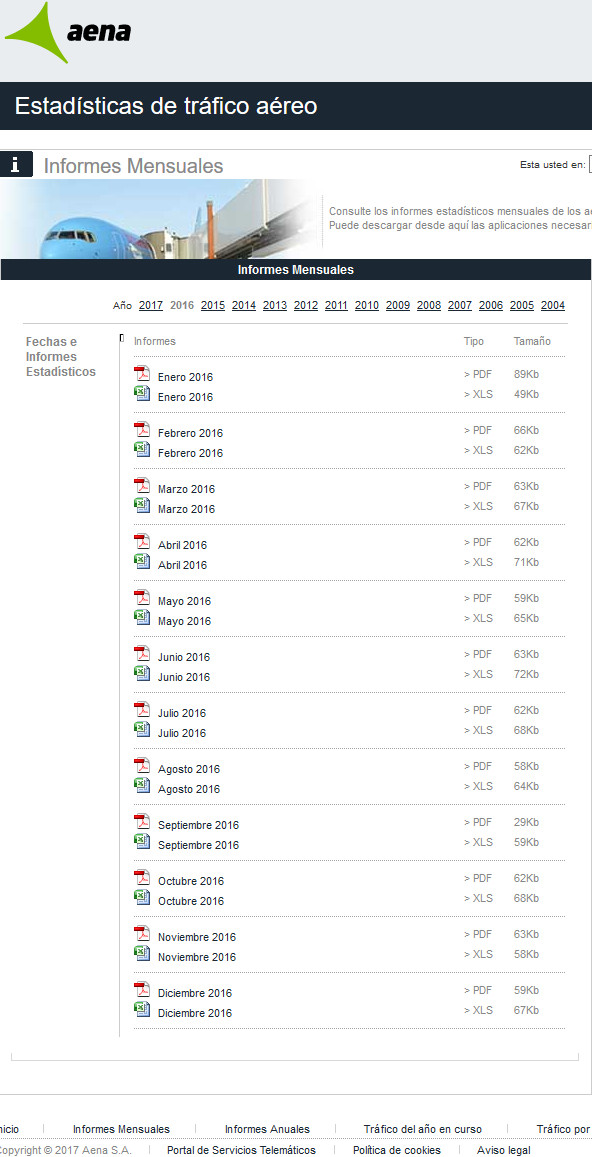 We find several sources for public accessible data. Sometimes you find it on the airport’s own website, somewhere in “Statistics”, sometimes in a press release, usually not in one, but in 12 press releases (see image). And even when publishing the annual numbers in one file, the file comes as a PDF, formatted that they cannot be extracted into a table but copy into one value a line. On a complex table, that renders that useless. So the airport forces users of their data to write the data off the PDF? You can’t be serious, can you?? Sometimes national airport associations publish the data, usually monthly. After we found them to occasionally change the formatting and order even within a given year, we double-check that on the import, burning valuable time. Then we learned to now download monthly data before the annual one was available, as we also happened to fall the trap of intermittent changes (see ANNA.aero). Many such files do not contain the airport codes. But the airport name in the national language. Upper case. No, that does not compute easily and is prone to cause data errors.
We find several sources for public accessible data. Sometimes you find it on the airport’s own website, somewhere in “Statistics”, sometimes in a press release, usually not in one, but in 12 press releases (see image). And even when publishing the annual numbers in one file, the file comes as a PDF, formatted that they cannot be extracted into a table but copy into one value a line. On a complex table, that renders that useless. So the airport forces users of their data to write the data off the PDF? You can’t be serious, can you?? Sometimes national airport associations publish the data, usually monthly. After we found them to occasionally change the formatting and order even within a given year, we double-check that on the import, burning valuable time. Then we learned to now download monthly data before the annual one was available, as we also happened to fall the trap of intermittent changes (see ANNA.aero). Many such files do not contain the airport codes. But the airport name in the national language. Upper case. No, that does not compute easily and is prone to cause data errors.
Even where Excel is being provided (like by AENA), the files are not ready for instant import, very often missing the unique IATA airport code that would allow to properly associate – but usually airport names in national and uncommon naming, requiring additional work to add the three letter codes to allow for proper import. And then you have those cases, where the monthly numbers do not sum up to the annual totals.
All in all, that shows the neglect airport managers handle “numbers”. Given that we all talk about e-Commerce for 20 years now and for 20+ years I keep addressing the data quality as an issue. Before the internet, airports published their data in the format they now provide by PDF. For journalists or other data providers to type them off. They simply moved the paper to the PDF, being a print format, not a data exchange format. They obviously did and do not understand that times have changed. Keeping with the times, they should maintain and publish the data in ways that they can be pulled using an HTML-call (returning a given-format CSV), if that is not possible, they should at least use an Excel file. If they change data, they should inform the data users about that. But nothing at all shows the modified file (rev.1, v.1), so in case of a discrepancy they enforce a check of all monthly files. Again, we talk about their main KPIs, something they should be interested to make sure that everyone uses the “right” number.
 Catchment Area Case Study
Catchment Area Case StudyBased on our (constantly expanding) catchment area case study about the numbers given by the airports, we understand the concerns, disbelief and rejection of such airport numbers by airlines. As any quick check from other sources (like our free isochrone analyses) unmasks them as useless, guesstimates or even intentionally beautified. I confronted Fraport Bulgaria with their given numbers in a brochure I picked up at ITB Berlin, being 2.3 to 2.5 times, or in percent 230 to 250% above our sound, European-wide calculations. Initially, they backed off, not knowing of the brochure, so I forwarded them photos of it. Then they referred to “drive time offsets”, neglecting the fact that we have comparisons on a European scale and even giving extremely ambitious drive speeds, that calculates to 10, 20% offset at the maximum on the population reach, but not to 230 or 250 percent! So instead of taking this up professionally, their managers decided to stick their head in the sand.
 Passenger Terminal Expo 2017
Passenger Terminal Expo 2017Speaking at Passenger Terminal Expo in the Management & Operations track (speaker notes here), I challenged my audience about Data Silos, Silo Thinking and the need to Tear Down the Walls. It addressed A-CDM and why A-CDM rather usually gets stuck in the early stage of the process. Silo Thinking and not invented here being the most common cause as all my friends in the A-CDM arena tell me. The same being true for airport managers. And an airport general manger told me: “If we don’t embrace that we got to exchange our data, we miss to do our job”. I was sorry I had to tell him his airport being one I don’t have the passenger data for yet.
Another Post Scriptum: These weeks, another several faces left our industry, another “trusted face” leaving UBM. Some few remaining in aviation at least, others move on to other industries, others again (like myself) struggle to keep in our industry.
Ever since I started addressing “Airline Sales & e-Commerce” in 1994″ at the Airline Sales Representatives Association (ASRA), I emphasized the importance of the “face to the customer”. A Logo, a face are things, users attach themselves to emotionally! It’s your emotional USP. Customers (“contemporary” B2B, B2C) knowing someone in the company attach themselves to it. That is not all, sure. Prices for example must still be competitive But not ultra-low. Reputation of the company can (and does) outweigh the price. But also the person you know there usually has an impact to who you make business with.
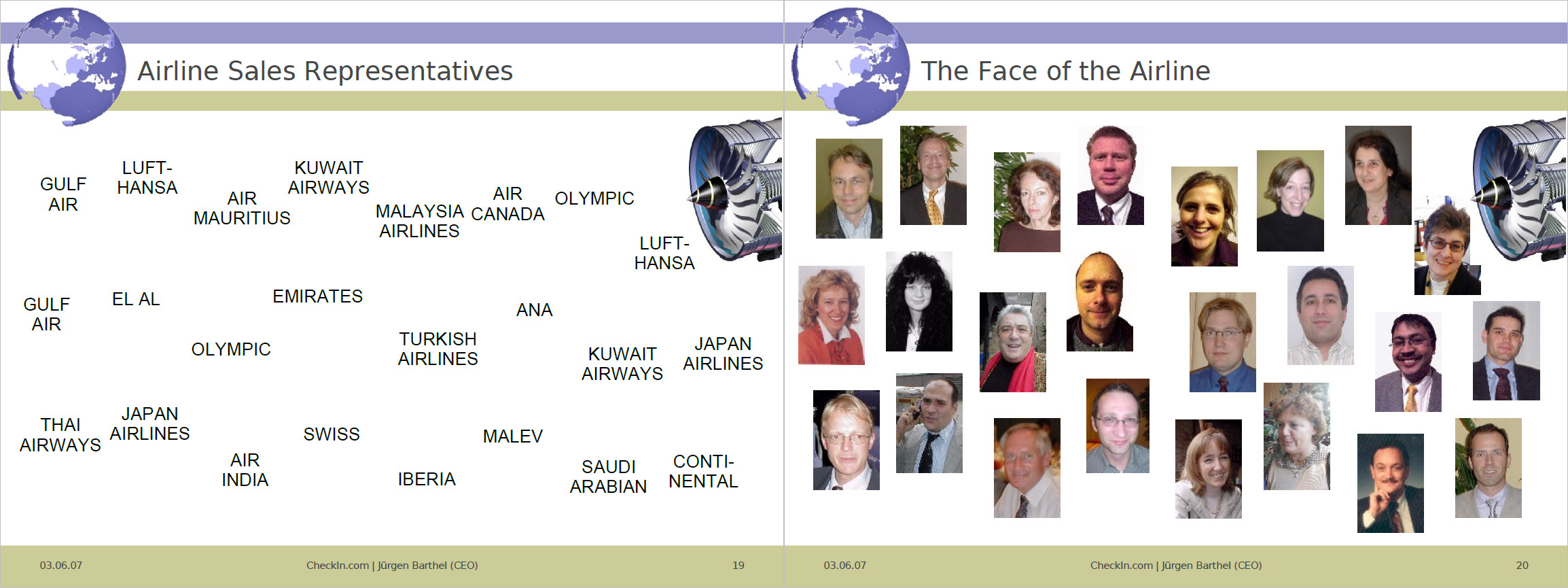
This is an example from 2007, explaining it to the ASRA members. Unfortunately, they proved they did not understand it. Neither the need as usually well paid Sales Managers to embrace the “new sales channels”; in most airlines the “traditional Sales” and “Social Media” are different divisions. Some airlines more recently trying to bring together what’s meant to be together, usually at the expense of the “old faces”. Nor did my ASRA fellows understand the importance of networking, the group fell apart two years ago and is meanwhile unregistered.
And let’s not go into brand management here, I addressed the idiocy to rename and kill brand identification often enough.
 “New Airline” Business Concept
“New Airline” Business ConceptIn the last weeks, I got approached about investors being interested to invest into aircraft, seeking which business model to use. The initial idea was Airbus A320 or Boeing 737, leasing that to the low-cost airlines. As if we wouldn’t have a record on the order books, long delivery times and the low cost airlines recently leasing their aircraft to other airlines as they find it increasingly difficult to find new routes. So I came up with a completely new model, quickly qualified numbers and viability and offered it to them. The intended aircraft maker learning about the idea took it up.
 Friends I introduced the business concept to, in order to qualify it and get questions about the viability answered wondered why no-one has established such a model yet. I think that takes a little hammer. Or some out-of-the-box thinking.
Friends I introduced the business concept to, in order to qualify it and get questions about the viability answered wondered why no-one has established such a model yet. I think that takes a little hammer. Or some out-of-the-box thinking.
Working on that concept and following up on Passenger Terminal Expo, also about my rather negative experience with HR and head hunters a discussion arose about a shortcoming of our business culture:
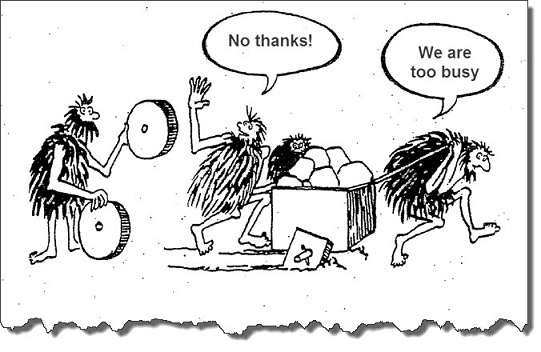 Narrow-Minded Management
Narrow-Minded ManagementWe mostly agreed, that most managers today encourage a narrow-minded thinking. This is your job, don’t you bother about the jobs that are managed in other departments. If you do in fact think outside the box, you challenge such managers.
Food for Thought
Comments welcome!
![“Our Heads Are Round so our Thoughts Can Change Direction” [Francis Picabia]](https://foodforthought.barthel.eu/wp-content/uploads/2021/10/Picabia-Francis-Round-Heads-1200x675.jpg)

As I outlined in my summary on the Hamburg Aviation Conference, my friend Daniel expressed his believe that within 20 years, there will be no more passengers fees.
At the same time, Michael O’Leary was recently quoted that he expects in very short time they will offer the flights for free.
But flying costs money, no matter how good the aircraft engines become, terminal construction and maintenance, ground handling, air traffic control, gasoline, pilots, cabin crews, aircraft, insurance, it all needs to be paid. And no matter how effective you calculate …
… someone has to pay the bill.
Airlines lower their ticket prices, covering the “loss” with “ancillary revenues”. While those “ancillaries” have been understood as services previously bundled (inflight meal, baggage, flight insurance), they meanwhile extend quite into “inflight shopping”.
At the same time, traditionally airport landing fees, split into the landing and passengers, covered for the airports’ cost of operations and development. This basic, sensible model is now threatened. It will change. But how. When the airline and airports fight for the revenue of the passenger – I believe both will loose.
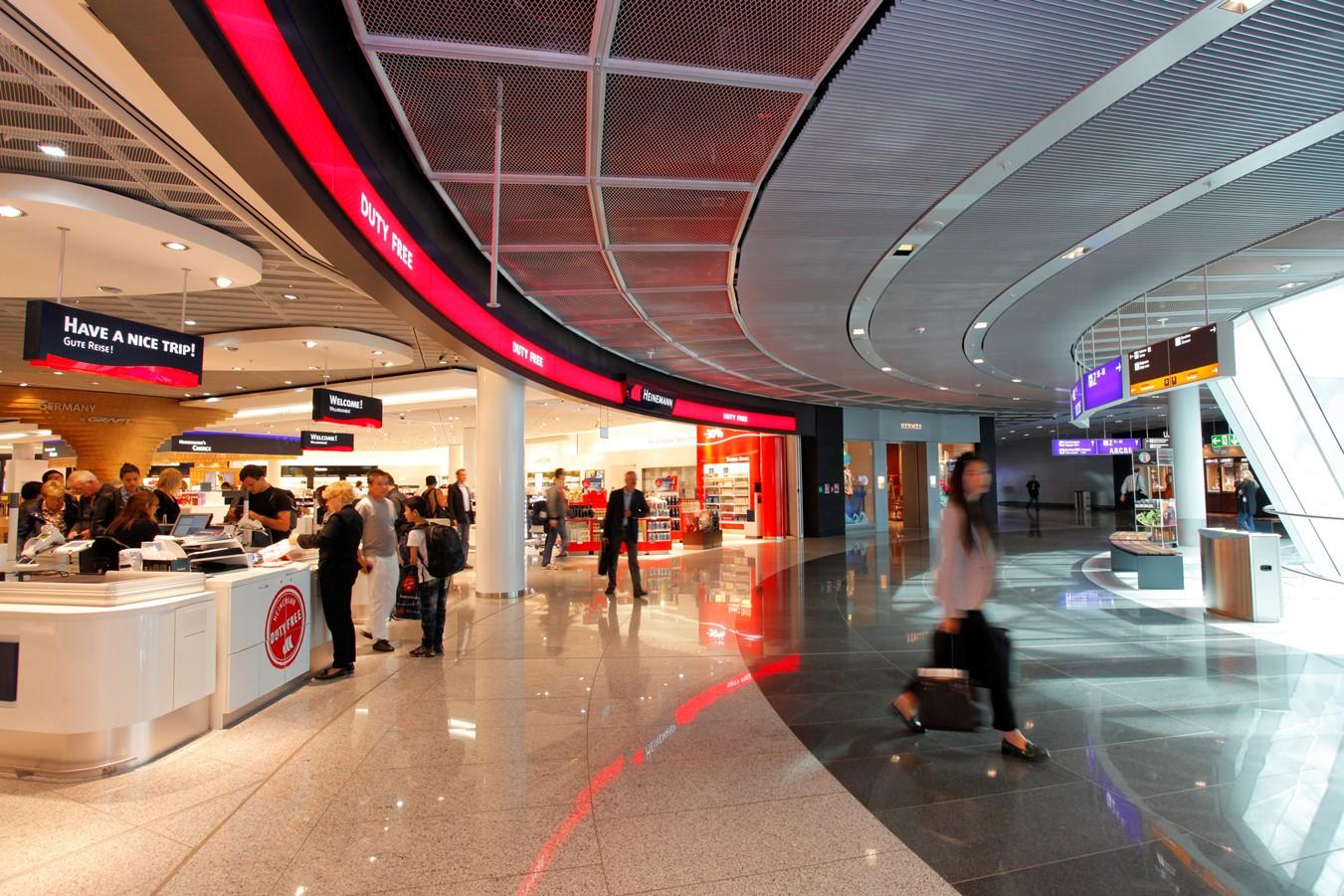
So currently it is a fight between airport and airline for the money of the traveler. I hear airlines expressing their anger about the airports increasingly draining the pockets of the passengers pre- and post-flight. And the airports upset about architectural changes enforced by the evaporating aviation income, forcing them to add shopping in arrivals halls and rebuilding terminals for improved shopping, i.e. forcing the passenger through the duty free store. Or how to speed up the check-in process to increase the dwell time of the traveler to spend more money shopping. And the shop owners about the increasing pressure to cash in on the passenger in order to pay the expensive rental deals with the airports. And, and, and…
And no, it does not help to imply that the politicos should provide airports similar to train stations. Yes, it is true, airlines bring business to the regions. Airports are important infrastructure. But in the end … someone has to pay the bill.
 What we will need is a serious, joint discussion about the future business model in aviation. At the moment there is no discussion. There’s the airlines, the airports and business models that cannot work. And we need to have the politicos and the usually government-controlled ATC (and border control, security, etc.), we have to have the ground handlers, the shops and all other players on the table. You can’t reconstruct all the small airports. We don’t need a fight. We got to work together for a sustainable business model. ERA, AAAE, IATA, ICAO, this is your call.
What we will need is a serious, joint discussion about the future business model in aviation. At the moment there is no discussion. There’s the airlines, the airports and business models that cannot work. And we need to have the politicos and the usually government-controlled ATC (and border control, security, etc.), we have to have the ground handlers, the shops and all other players on the table. You can’t reconstruct all the small airports. We don’t need a fight. We got to work together for a sustainable business model. ERA, AAAE, IATA, ICAO, this is your call.
Food for Thought
Comments welcome
![“Our Heads Are Round so our Thoughts Can Change Direction” [Francis Picabia]](https://foodforthought.barthel.eu/wp-content/uploads/2021/10/Picabia-Francis-Round-Heads-1200x675.jpg)

At the recent Hamburg Aviation Conference one of the speakers questioned all those airport different apps. And it reminded me of my issue about a common login process for the airport wifis. But then he questioned, that all those apps simply don’t make it to the users first screen. Initially 16, meanwhile on the larger phones more like 24 apps fighting for the attention of the user.
Then my friend Erica forwarded me that Wired-article, addressing the increasing problems the news-industry has with their advertising-driven business model. Which reminds me of those magazines I happen to read. And I simply thought, what they do wrong from my very personal point of view.
What is the advantage of Google, Facebook and those new players? If is their ability to intelligently and dynamically associate my interests and provide me with the information I am interested in. To show me that on the first page. Without omitting other possibly interesting information. Even the advertising is targeted (which requires mass). And we happen to believe that intelligence.
Until we switch to the time-line view. In Facebook with /?sk=h_chr – in LinkedIn no such URL-tweak since Microsoft took over, but if you use the browser you can hover your mouse on the … on the right above the first news, selecting “Recent Updates”. Yes, I use Google, but I understand they also mix advertising in. But…
 Ow-my-gawd, but I’m German, what about my personal data and stuff?
Ow-my-gawd, but I’m German, what about my personal data and stuff?
That was another topic we discussed in Hamburg. Travelers and readers are willing to give personal information … If. It. Makes. Sense.
No, I do not want to drop my pants for a general news headline or another “case study”. And I do not like to use “real data” when someone asks me to download this nice new study they did. Have Feivel Mousekewitz on your mailing list bouncing? Good chance I’ve accessed data without seeing the need why I should add myself to a mailing list of yours. Oh yes, and I assign “custom e-Mail” to many of those and it’s wondrous who sends me advertising and how quickly on many of those “trusted business partners”!
 And I do not want to get another app. Ages ago, I decided to limit myself to 10 newsletters and two or three social networks. Facebook I use mostly privately. LinkedIn for business. And LinkedIn being “difficult” both in Russia and China is an issue of concern. Google+ I dropped. I use airline apps on my travels, in fact only to get the boarding pass into my phone’s “wallet”. I used some apps for airport information, just recently learned about FLIO and try that now. But pay? Or apply profile? What’s in it for me? I like TripIt to take track of my travels, though since it was acquired by Concur and Concur by SAP it’s anything but perfect. Same as with Skype and LinkedIn since they got part of Microsoft.
And I do not want to get another app. Ages ago, I decided to limit myself to 10 newsletters and two or three social networks. Facebook I use mostly privately. LinkedIn for business. And LinkedIn being “difficult” both in Russia and China is an issue of concern. Google+ I dropped. I use airline apps on my travels, in fact only to get the boarding pass into my phone’s “wallet”. I used some apps for airport information, just recently learned about FLIO and try that now. But pay? Or apply profile? What’s in it for me? I like TripIt to take track of my travels, though since it was acquired by Concur and Concur by SAP it’s anything but perfect. Same as with Skype and LinkedIn since they got part of Microsoft.
But yes, it is a constant fight for space on my first smart phone screen. Or for my PC’s Windows start menu (which I customize for the sake of finding what I “need”). Yes, I’d like a single (trusted!) app to do it all.
I use phone (1), messages (2, SMS, iMessage), Facetime (3) and Viber (4, video calls), mail (5), calendar (6) and address book (7). Camera (8) and camera library (9), eBook-Reader (10), Musicplayer (11), Videoplayer (12). Maps/Navigation (13) and weather (14). Facebook (15), LinkedIn (16), browser (17). Twitter, Skype, WeChat, etc. are on the secondary page. I use Shazam (18) to identify songs I hear somewhere. Threema (19, secure messenger), Trello (20) and PayBack (21, shopping loyalty card). Amazon and IP-TV were moved to secondary pages too. A single (trusted) general news source (22). And AirVideo (23) for at home access to our video archive. My phone only has 24 spots, so the last one is used “ad hoc” as needed. For Hamburg Aviation Conference they asked to use Slack (which did not make it to my permanent apps). Routes has its own App. Where would I put “airports”? Even as a frequent traveler, I have either Wallet on the first page for travels. Or maybe FLIO. There was a time I had four or five screens. I have two left. A third if you consider the “travel” folder with all those travel apps I only need on occasion.
Want to make it to my phone? What shall I remove for the sake of your app?
So I think, the airports must ask themselves, it it truly makes sense to bet all their money on their app. Or if they should look for an aggregator, providing their information from a single app. If I travel i.e. from Berlin via London to Belfast, that I do not need three apps, but a single one. If I use the commercial lounge in London, same app. If I want to use WiFi inflight and enroute, same app. But that requires common standards. Which brings me back to Data Silos and the need of common interface standards I addressed in my last post and will address at PTE.
We need common interface standards.
We need to tear down the silos.
We need to communicate.
Food for Thought!
Comments welcome

As I attended to be interviewed about the stuff we do at CheckIn.com, you can click the image to view the video on Facebook.
Reviewing the recent Hamburg Aviation Conference, the aviation conference addressing new developments and ideas, it boils down to a “known issue” for the future of the aviation industry:
To tear down the walls.
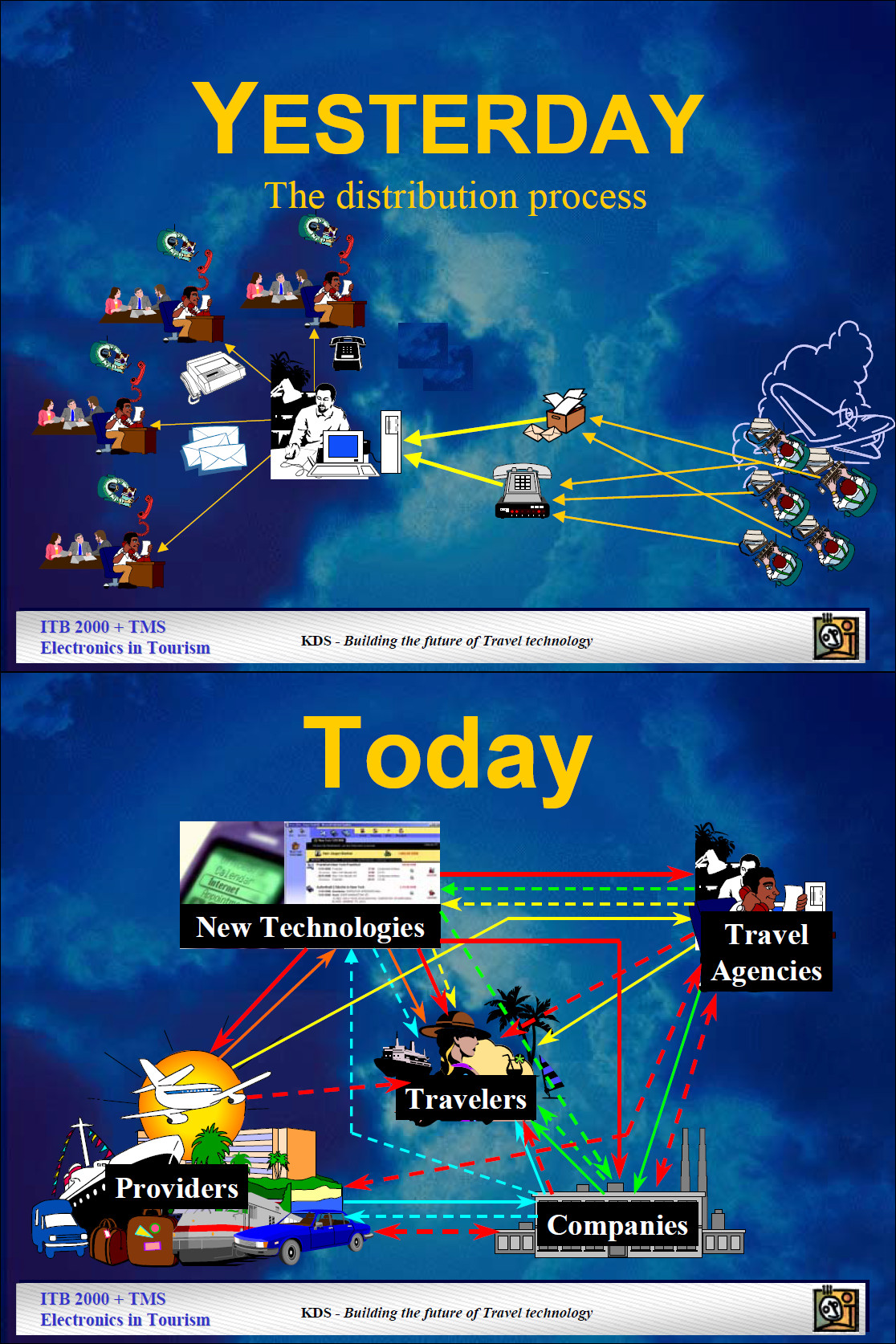
As outlined here in Food for Thought and have been asked to address at Passenger Terminal Expo, there were a lot of very fancy ideas and outlooks where we want to go. About any session addressed the “data silos”. There are a lot and I mean a lot of good ideas and developments taking place as we speak. But all of them are isolated ideas and developments. Look at what airline X does. See here airport Y.
Just one of the many statements at Hamburg Aviation Conference on the topic:
“The check-in process is a totally disjointed process” [Peter Parkes]
Remember my posts about Checkin 2015 and the follow up Check-in 2020?
The underlying line I hear, though not really addressed, just mentioned, is the data silos. Even when being mentioned, it was mentioned as something that “naturally” has to happen. But without it, all or most of those wonderful developments remain what they are. Silos. Be it an(other) airport-silo, an(other) airline-silo, silos being disconnected from the other silos within the same company.
But. This. Is. Not. New! Together with Richard Eastman, from 1996 I emphasized the conversion from a whole sale model to a consumer driven model and the disintermediation in aviation distribution: Everyone deals with everyone. The example Yesterday / Today to the left is from my presentation at ITB in 2000.
 On the floor, there were many discussions that there is a need in “change managers”, as there are all those fancy solutions and understanding of the need. That again reminded me of my question, why after 20 years only 20 airports implemented A-CDM – in my opinion for the very same reason. Everyone talks about it, nobody really knows how to do it, everyone thinks everyone else is doing it, so everyone claims they are doing it…
On the floor, there were many discussions that there is a need in “change managers”, as there are all those fancy solutions and understanding of the need. That again reminded me of my question, why after 20 years only 20 airports implemented A-CDM – in my opinion for the very same reason. Everyone talks about it, nobody really knows how to do it, everyone thinks everyone else is doing it, so everyone claims they are doing it…
There were quite some discussions about the data silo issue and airports and tech companies telling about those very new and fancy solutions they develop. But when I look across to other airports, airlines or tech companies, I find they just build new Data Silos.

Data Silos are simply the result of the real problem.
It’s about “who’s data is it?”. It is about the decision makers and stakeholders unwillingness, inability and misconception about a collaborative approach: “Give me your data but don’t date touch mine”… The very same as on the A-CDM side of our business.
The point when the aviation industry reinvented itself and evolved into e-Commerce was back in the 60s t0 80s, when the rise of the CRSs required standardized messages to exchange through the aviations teletype (telex) network. The birth of what today is AIRIMP. Nowadays, IATA works on “New Distribution Capabilities“, though there are fundamental issues when you compare airline sales to Amazon. Where Amazon works with warehouses and even opens own shops, the airline seat is one of the most perishable goods – something Amazon for good reason touches very differently.
The second large move was again forced, when in the mid 90s to 2000 the Internet forced the players to “get online”. Since 1994, I preached the need for airline sales to embrace that change.
I mentioned A-CDM and TAM as a starting point to tear down those walls, but I see a lot of not invented here responses.
 Some of the really good ideas in the dead lock of silo thinking, where about one of the new hypes: The Passenger Journey.
Some of the really good ideas in the dead lock of silo thinking, where about one of the new hypes: The Passenger Journey.
When talking about the customer, how do we identify that very customer? By e-Mail? I just happen to change my employer at times. And I get a new address. I currently run three “main addresses” and use different ones for the various social networks. If you identify me by e-Mail, I use a different one when I travel for business than what I do personally. I’m two customers. Data Silos.
There was quite some talk about the need of the “passenger journey”, but also how fragmented that journey is. No wonder, the passenger being split to “airport customer”, “border control/security”, “airline” and the exchange of the traveler from one to the other complicated by Data Silos.
Around 2000, I mentioned in my annual presentation about Airline Sales & e-Commerce for the Airline Sales Representatives Association, that Google was said to identify a unique person within 20 searches, based on IP geographic area, typical questions, etc. That was what … 17 years ago? And we don’t even have a single source of truth for a passenger in aviation. Very often we have separate profiles even within an airline – for GDS/CRS (old legacy tools), check-in and operational processes, but separate for social network contacts. A customer contacting via Twitter or Facebook is (in my experience) usually not associated to the passenger profile! Some examples to the contrary, usually on the large and newer players (i.e. Norwegian, easyJet). Is this a premium customer on the social network or is it a first traveler? Is it someone enroute or at home? Data Silos.
At lunch we talked about another example. I may be a prime customer (“frequent flyer platinum”) at airline A, but I have trouble, getting recognition at airline B. Because it is not about being a frequent traveler, it’s solely about revenue. You are not with us, we don’t want youThat a good treatment of the frequent flyer on your competition might entice him/her to your own product is beyond the decision makers in most if not all airlines. Data Silos? Silo Thinking!

On the “customer journey”, every stakeholder forces the customer to change Wifi on the way, use an app for the airport, the airline, the other airport, etc., etc. I mentioned that back in my Check-in 2020 blog.
Whooops. And my friend Stephan Uhrenbacher has to tell me he had an app developed that does it all: FLIO. But… Unfortunately the providers don’t want this, they oppose it and fight to not make this happen. And the airport WiFi is hardly in the control of the airport, but of “some provider” the airport just pays. So they want their log-in processes and pages and have no interest in “usability”. That being true especially on the U.S. market, where in addition the “free WiFi” very commonly fails and then the users complain about FLIO and not about the free WiFi provider of the particular airport. Stephan promised me, the idea is not dead, but yes, the task is not as easy as it might sound. Thanks to Data Silos.
Kenny Jacobs in his very interesting interview announced they complained legally about the Lufthansa/Air Berlin merger, saying that is what it is, being called a “lease” business or whatever. As such, Germany remains a protected market with Lufthansa dominating 62% of the domestic travel.
in his very interesting interview announced they complained legally about the Lufthansa/Air Berlin merger, saying that is what it is, being called a “lease” business or whatever. As such, Germany remains a protected market with Lufthansa dominating 62% of the domestic travel.
Side note: That also goes in line with the trade press reporting the remaining Air Berlin being not sustainable. Questioning if Air Berlin is now simply bled dry, leaving the commercially loss making parts in the remaining company, accepting the bankruptcy as a logical end to it. I happen to agree with that assessment.
 He also announced they will feed to Aer Lingus and Norwegian on an “interline light” model but with baggage thru-check. Another step from Low Cost to classic operations model. As I kept emphasizing in my Airlines Sales & e-Commmerce presentations. Low Cost will only need a business case to provide “classic” services. Also nice to remember that ANNA.aero article a year ago (right).
He also announced they will feed to Aer Lingus and Norwegian on an “interline light” model but with baggage thru-check. Another step from Low Cost to classic operations model. As I kept emphasizing in my Airlines Sales & e-Commmerce presentations. Low Cost will only need a business case to provide “classic” services. Also nice to remember that ANNA.aero article a year ago (right).
Ryanair develops inhouse, for speed and prioritization of development. Ryanair decided to stop looking at other airlines what they do on their digital strategy, but they look at digital pacemakers, Amazon, Facebook, etc. to learn what they can do to attract the customer.
WiFi onboard? Consumers want to use their own devices on board. But the bandwidth inflight is not sufficient for mass communications. He believes the speed to come up in two years, but then the bandwidth demand will also increase. Yes, for long haul, but on regional flights not a real issue he believes.
 Konsta Hansson of Reaktor.aero had an interesting look into user centric design, not to decide for the user what he needs, but find out what the user needs and leave out the rest. He questioned if a check-in is a given need – or just a legacy process. Using RFID and e-Passports, I strongly agree with him.
Konsta Hansson of Reaktor.aero had an interesting look into user centric design, not to decide for the user what he needs, but find out what the user needs and leave out the rest. He questioned if a check-in is a given need – or just a legacy process. Using RFID and e-Passports, I strongly agree with him.
Question I’d have and could not answer is based on the assumption that “check-in” is obsolete, how would you really refresh processes from the existing legacy processes to a completely digital process? And how do you manage the necessary change management with stake-holders like government bodies? Data Silos.
 Shall the passenger be shopping in the airport or in the airplane?
Shall the passenger be shopping in the airport or in the airplane?
My three friends Stefan, Daniel and Marjan were on stage, discussing the different models the airports have to decide upon about their revenue stream for the passenger, called “ancillary revenues”. Daniel emphasized that within 20 years, the revenue for the airports no longer comes from the airlines. But (declining) from the in airport shops and (increasingly) the aerotropolis.
With Ryanair talking about “free tickets”, keep in mind, there is nothing such as a free meal. Someone will have to pay the air ticket somewhere in the process.
 There was a lot of visionary ideas about where to go, but rather little about how to get there. The above concerns were quickly voiced but not identified as concerns. Steps taken are taken by individual stake holders (technology companies) and less on a development of common standards. So we have fantastic ideas, but we all keep develop our own individual standards = Data Silos. And worse: Silo Thinking!
There was a lot of visionary ideas about where to go, but rather little about how to get there. The above concerns were quickly voiced but not identified as concerns. Steps taken are taken by individual stake holders (technology companies) and less on a development of common standards. So we have fantastic ideas, but we all keep develop our own individual standards = Data Silos. And worse: Silo Thinking!
We talk about “passenger journey” but the solutions are neither user centric nor easy to use. There was recently a story on LinkedIn titled Brand suicide case study: British Airways I strongly recommend… It is a good example about Data Silos, Silo Thinking and not specific to the named airlines. The same story unfortunately is true for most airlines. What we need is a management effort to Tear Down the Walls!
Food for Thought!
Comments welcome
… and if you happen to have a job for me looking after this, please keep in mind I am a job seeker!
1 - click to show Jürgen you liked the post![“Our Heads Are Round so our Thoughts Can Change Direction” [Francis Picabia]](https://foodforthought.barthel.eu/wp-content/uploads/2021/10/Picabia-Francis-Round-Heads-1200x675.jpg)

As you may know following my blog, I am considered an expert in aviation.
 At upcoming Passenger Terminal Conference & Expo, I will speak about the need to dear down the walls to make A-CDM a success. Being it data silos or the ones in the heads of the ones opposing change (aka. change management).
At upcoming Passenger Terminal Conference & Expo, I will speak about the need to dear down the walls to make A-CDM a success. Being it data silos or the ones in the heads of the ones opposing change (aka. change management).
At upcoming Hamburg Aviation Conference, the famous aviation think tank, I will be on stage on our work at CheckIn.com. As an example for pioneering work, changing the status quo: That is it … is it?
I work with airports and airlines and get calls on many projects every day, being asked for advise and “just a little help”. But at the same time, the expenses still exceed the income, not talking about a possible “salary” on our work on CheckIn.com. On my airline startup investment, we get a lot of market research inquiries, but we shall develop and deliver that for free for the chance of a future investment.
It reminds me of the old joke on the social networks about asking for free consulting: “If I wanted to work for free, I’d choose to be a volunteer. Not a freelance.” And while all those callers have a well-paid job, they hide behind their company not being able to pay me, but I sure will get their “business” later. Can’t tell you how often I heard that.
 I’ve lately being asked to travel to North America. And to Russia. To help on a project. Payment? Oh, if my help works out we may be able to agree on a consulting contract the next time… You. Got. To. Be. Kidding. Me.
I’ve lately being asked to travel to North America. And to Russia. To help on a project. Payment? Oh, if my help works out we may be able to agree on a consulting contract the next time… You. Got. To. Be. Kidding. Me.
As a boy, I loved the biography of the Nobel-price-winner Marie Curie, about whom Wikipedia writes: “She subsisted on her meager resources, suffering from cold winters and occasionally fainting from hunger.” But she did have a dream. And she lived it.
Now it’s time. Not “tomorrow”, not “some day”. I mention on my social networks that I look for a new challenge, paid work. I’m busy all day, work long nights, but that all comes without enough pay, so we dig into our savings – not what I want life to be. Neither my wife, nor my children.
More friends have left our industry this year, not finding decently paid work in our industry. Being seasoned, creative experts in aviation, they now work in other industries paying them their living. If you pay €30K/year for a “manager” position, you get what you pay for.
I keep answering my friends (close and loose) questions, share my experience. Just keep in mind when you ask a freelance for free help, that if you use their time, they have less time to make money and feed their family, their children. And don’t promise “exposure” to “opportunities” that we both know they won’t arise. It might be an idea to not imply that your company doesn’t have money to buy into expertise. You might simply not have asked. Or did you?
Food for Thought
Comments welcome
And I wish everyone happy holidays and a wonderful, prosperous, challenging, healthy and fun 2017.
See you in Hamburg (08-09Feb), Ajaccio (22-24Feb), Amsterdam (14-16Mar) or Belfast (23-25Apr). Or elsewhere.

0 - click to show Jürgen you liked the post
![“Our Heads Are Round so our Thoughts Can Change Direction” [Francis Picabia]](https://foodforthought.barthel.eu/wp-content/uploads/2021/10/Picabia-Francis-Round-Heads-1200x675.jpg)
LinkedIn makes it to my personal blog for three reasons this week. The LinkedIn ban in Russia, the naming of our LinkedIn Group and our experience with LinkedIn promotions of our posts.
I also add a note about why we give away Isochrones for free, but call ourselves “The Isochrones People”.
 LinkedIn Ban in Russia
LinkedIn Ban in RussiaAs much as it is a “political signal”, one must keep in mind that the rules were long known and other companies invested big money in Russia to store the personal data of Russian users in-country. Further, German and European Data Watchdogs (Datenschutzbeauftragte) also demand storage of that data in Europe (mostly a reason for big data centers built and used in Dublin).
As we are in preparations at CheckIn.com to add Russia (on demand by an airline customer), we added a new blog ad hoc to our page (not yet in our look-and-feel) to promote what we initially started using LinkedIn for. Though that already was on the back-log of things to do, relating to the LinkedIn promotions we address below.
 LinkedIn CheckIn.com Group
LinkedIn CheckIn.com GroupA few weeks ago we created a group on LinkedIn to address the non-commercial side of the business of analyzing catchment areas, things like isochrones or why travelers choose an airport against other airports. Distance is just one reason, reputation (both airport and airline), prices and frequency. Commercial and personal relations (VFR, visiting friends and relatives) and tourism can influence the decision of the travelers to choose an airport over the other(s). Where we identified an average of 10 airports being competitive to other airports in Europe and five usually having an impact on travelers, studies say that people usually look at one airport as “their” airport with maximum of two others as “options”.
That’s what we won’t discuss as “news” on a commercial level, they are to frequent to discuss on my personal blog, they are neither focused on airline network development (but part of it like MIDT). So I decided that we set up a group and I looked at other commercial-interest groups. I could have set up “Catchment Area” or “Isochrones”, but that way may have attracted people from other industries and I wanted to keep an aviation focus to the group. So I decided to name it CheckIn.com. In the long run, we may rename it to CheckIn.org revitalizing the respective website with a good cause that is currently still hosting the Airline Sales Representative Association that broke up and disbanded 2015.
Other website? Why not the LinkedIn group?

As it happens, I have been a long-year supporter of LinkedIn, I do love the social networks for keeping in touch with people I know and value. I only confirm links on my social networks to people I have a relation to, be it personal (mostly Facebook) or business (mostly LinkedIn). I liked the groups on LinkedIn and the company profiles, even decided to set up a LinkedIn company page to promote our news – and a group for the stuff that’s not commercially driven. But in the past months since, I found posting on LinkedIn outside my own profile not to make much sense, neither professional, nor personal. In average, less than 10% of my network react on my posts – and that’s mostly the same people.
At the same time, any article I write here on my personal blog is being read and results in more responses (though mostly personal, not on the blog) than any LinkedIn post. And on the example of this year’s mostly accessed post on Purchasing Power & Airports last March, that one even in the past month showed as the top post by 482% to the next best one, The Numbers Game. Almost 5 times more for the Purchasing Power. Seems it is being spread on channels beyond my own “control”. Which is what social networking is all about.
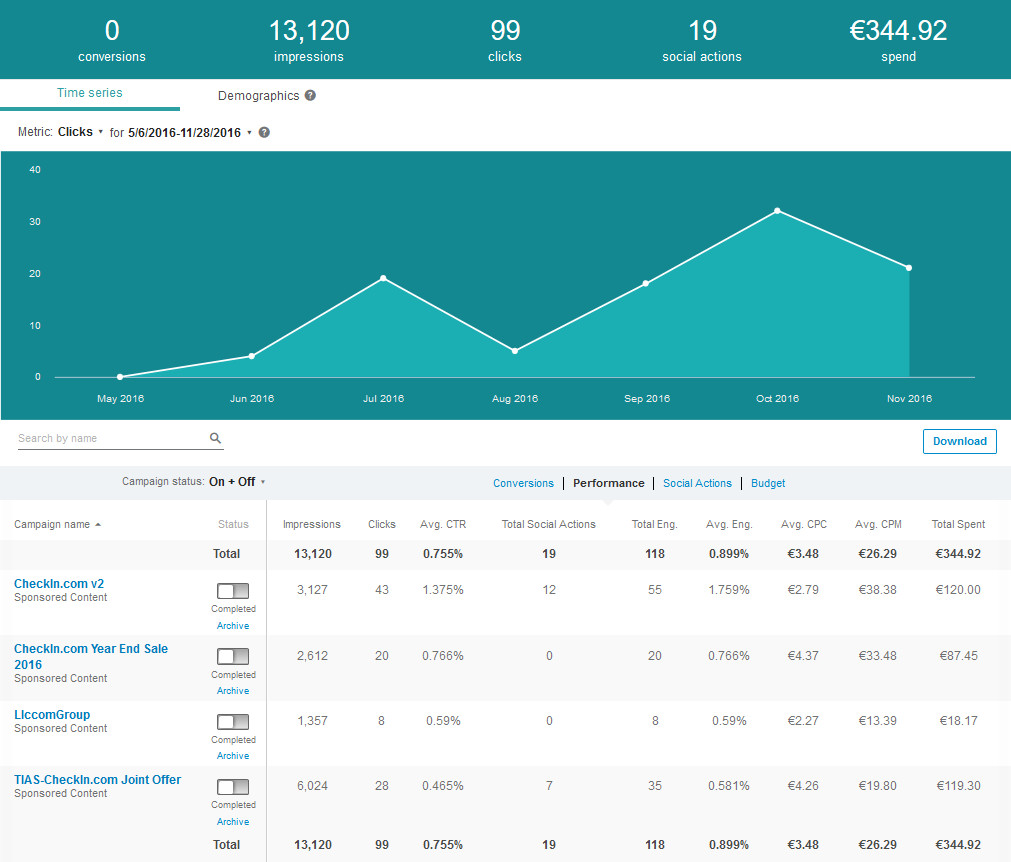 We did a promo for our company page and our group (click on the graph to see it real size). Where the group does not have the commercial focus! We have 10 members on the group, we have 51 followers on the company page on LinkedIn. Out of … how many contacts I have from events like Routes or Connect who I consider that they should be more interested in the issue? Out of those, how many have registered on our website? It’s free. It gives a very clear value: Free Isochrone Map and Facts! And even with some new followers, still the majority of users on our company profile did not register on our website.
We did a promo for our company page and our group (click on the graph to see it real size). Where the group does not have the commercial focus! We have 10 members on the group, we have 51 followers on the company page on LinkedIn. Out of … how many contacts I have from events like Routes or Connect who I consider that they should be more interested in the issue? Out of those, how many have registered on our website? It’s free. It gives a very clear value: Free Isochrone Map and Facts! And even with some new followers, still the majority of users on our company profile did not register on our website.
I mailed my contacts directly (personally) with a prepared mail text (using poMMo, which I also use for many years for other such updates like the birth of my daughters). Interesting enough, about every airport I talked to keeps telling me excuses and that they “will register”. We’re not talking to buy the more complex analysis, we talk about a simply, free registration to access the incredible amount of data we provide for free. Airlines are more active than them. About any airline I so far contacted in Europe has registered. And uses the data. And the first order analyses and they support actively asking pointed questions, especially about the route level analysis we are having in development. But they take what we have now, which we believe to be more likely of interest for airports. Interesting there also: For some reason my contacts I know best and considered “save” mostly have not yet even registered. But people I know just a bit, they come and show interest. And invest. And invest again. So they like what they get, they understand the value, my “friends” obviously don’t.
Worse for LinkedIn, even on articles posted (LinkedIn Pulse), they have a lifetime of max. 3-4 days, on blog and mail, we sometimes get response weeks later. On our blog, as for the example above, even months later, the unique visits are substantial!
And then the news hit, that LinkedIn has been banned from Russia. See above…

So we decided this week that I add a blog to promote news directly on our website. We do collect ideas for a “version 2” of our website, so far we still invest. I keep looking for work as we can’t live of our work at CheckIn.com (yet) and all money goes into improvements. I will still support Yulia on CheckIn.com, but it’s her company. And we prefer to pay for developers, mapgicians and mathgenies… Anyway, side-tracked 😉
We did expect airports though to understand the insane quality they get for a fraction of what they paid so far for far less. We give the “classic” Isochrone Maps for free: As we outlined in the new News, we see them as insufficient basis for any decent route calculation. Over the next weeks, we will transfer the LinkedIn posts there and refer from LinkedIn to the posts on our own site.
 The Isochrones People
The Isochrones PeopleA question that came up this week again, was why we promote that Isochrones are not Catchment Areas, but call ourselves The Isochrones People?
During pre-launch we learned that Isochrones and Catchment Area analysis are used as equal. Isochrones are also – and will remain – the basis for our analyses. Beyond the reach of the typical isochrones, in the background we calculate something like 6-8 hours “reach” for which we calculate drive times – beyond we go into “statistical noise”. But when we talked to our supporters from airports, airlines and consultancies about “The Catchment Area People” vs. “The Isochrones People”, there was immediate understanding what we’re doing on the latter one. And similar many questions about the first… Like “isn’t that the same?”
It’s a catch-phrase, people working in our industry shall identify as as the leading source for such information. And hey, we give them away for free, so yeah, I’m happy with being one of “The Isochrones People”.
Food For Thought
Feedback welcome!
![“Our Heads Are Round so our Thoughts Can Change Direction” [Francis Picabia]](https://foodforthought.barthel.eu/wp-content/uploads/2021/10/Picabia-Francis-Round-Heads-1200x675.jpg)

This week, I happened to stumble across this Wikipedia article: https://en.wikipedia.org/wiki/Not_invented_here
Then I stumbled across this image.
It reminded me very much of my experience with A-CDM, where most larger airports’ IT rejects external solutions in order to build a custom-made solution. After several years of work, we have several tires (or tiers?) of different size, incompatible to build upon.
It’s the same argument I hear from many airports and airlines when talking to them about CheckIn.com.
It will take time (and interest) until they understand that it’s not just another “same”, but something fundamentally new.
Linus Torwalds, inventor if the Linux operating system said: “The NIH Syndrome is a Desease”
Food for Thought
Comments welcome
![“Our Heads Are Round so our Thoughts Can Change Direction” [Francis Picabia]](https://foodforthought.barthel.eu/wp-content/uploads/2021/10/Picabia-Francis-Round-Heads-1200x675.jpg)

KPIs or “Key Performance Indicators” are considered a vital management tool to measure staff performance. But especially in aviation, we must be very much aware of the weakness of the KPI idea.
An old question on KPIs is “How do you calculate ‘service’?” If the company does good product, service is of low need. Their KPIs are low valued. So service is frequently outsourced by those wise guys (and gals). On the other hand, if you produce crap, “service” covers for it (or should) and is in great demand. Then it is easy to generate good KPIs. Large call volumen, strong problem solving, low loss of customers.
But in both cases, good service usually needs “reserves”, so if you keep your head count low, once something happens (and that’s rarely under controlled circumstances, prepared for or in the responsibility of the service team), you need “all hands on deck”. If you outsourced your service to save money, that’s when the bill backfires on you…

Another good example are flight attendants. They are not there to serve your every whim, they are not the “Saftschubsen” (juice pushies) they are often disrespectfully named. Once you had your very first inflight emergency, you hopefully start to understand their real value.
Why is it that I know senior airline managers who still try to argue that you need one or two flight attendants less on the flight for service reasons and they have to be reminded of the requirements by aircraft makers and governmental aviation bodies that that many flight attendants are certainly needed to evacuate aircraft.
In my experience and not just mine as I see from discussions and comments, KPIs are being (ab)used by accountants (up to CFO or CEO) to “measure” stuff they do not in reality understand. KPIs are also used to discourage staff from working beyond the line of duty, to find “reason” by disqualifying them from benefits and bonuses.
There’s a good reading on KPIs in Marketing. Addressing the immeasurable impact of your competitors action. Or that you hardly ever launch a single marketing campaign, but you’re likely firing on all cylinders, ain’t you?
Very, very few companies understand that KPIs must be used without “threats”, not as a “measure”, but as a means to improve products, services. What’s the number of complaints? How have they de- or increased and not just that, but most important why. Don’t “blame”. The “blame game” is for shortsighted idiots to play. KPIs can be set together in a team for motivation. If they’re dictated (openly or implied) by your boss or worse, used against you, they won’t work.
 There was some buzz on LinkedIn this week on Disruption Management. Bringing to mind how an airport I worked with disqualified their own historic KPIs as trash by implementing a check on the reasons for disruptions. Where before the airline was responsible for the brunt of all disruptions and delays, suddenly ATC, weather, ground handling or security became clear problems. But in the past it was so much easier to click “airline” and not research what was the real cause. So the real cause never got addressed. To low on the KPI scale. Whooops.
There was some buzz on LinkedIn this week on Disruption Management. Bringing to mind how an airport I worked with disqualified their own historic KPIs as trash by implementing a check on the reasons for disruptions. Where before the airline was responsible for the brunt of all disruptions and delays, suddenly ATC, weather, ground handling or security became clear problems. But in the past it was so much easier to click “airline” and not research what was the real cause. So the real cause never got addressed. To low on the KPI scale. Whooops.
There was also a very good article about KPIs and triggers on LinkedIn. It clearly votes for “internal triggers and motivation”.
Don’t get me wrong. On any projects I worked on in the past years, I used KPIs and Milestones. My own that is. But if I would have made them my mantra, I’d have achieved nothing ever. As a fire-fighter, you don’t care about the water spent. You blow out the fire. And at least for me, my KPIs and Milestones are taken like all good plans. They hardly ever survive meeting reality. So I don’t take them for granted, I adjust them to reality and use them to measure the planned vs. the achieved performance to identify why I turned out better or worse. Not for blame. But to learn to better forecast… To learn for the next project to apply KPIs that are more realistic.
While Einstein said: “Not everything that can be counted counts. And not everything that counts can be counted.”
Drucker said: “If it cannot be measured. It cannot be improved.”
 Both are right, but if you make numbers the only thing that counts for you, you have no vision, will never make a dream come true. KPIs are a tool from a large tool box. It needs an master artist to sculpture something beautiful out of someone’s imagination. It’s so similar to what we do at CheckIn.com. We crunch numbers, but we cannot predict the future. Don’t believe in the numbers only. But use them to solidify (or disqualify) your intuition! But I would have bet against some new routes in the past ten years that turned out surprisingly stable business! It takes guts to sometimes run a controlled risk. If you don’t play, you cannot win. Then use your own previously assumed KPIs (also i.e. load factors, yields) to learn.
Both are right, but if you make numbers the only thing that counts for you, you have no vision, will never make a dream come true. KPIs are a tool from a large tool box. It needs an master artist to sculpture something beautiful out of someone’s imagination. It’s so similar to what we do at CheckIn.com. We crunch numbers, but we cannot predict the future. Don’t believe in the numbers only. But use them to solidify (or disqualify) your intuition! But I would have bet against some new routes in the past ten years that turned out surprisingly stable business! It takes guts to sometimes run a controlled risk. If you don’t play, you cannot win. Then use your own previously assumed KPIs (also i.e. load factors, yields) to learn.
How do you use them?
Food For Thought
Comments welcome!